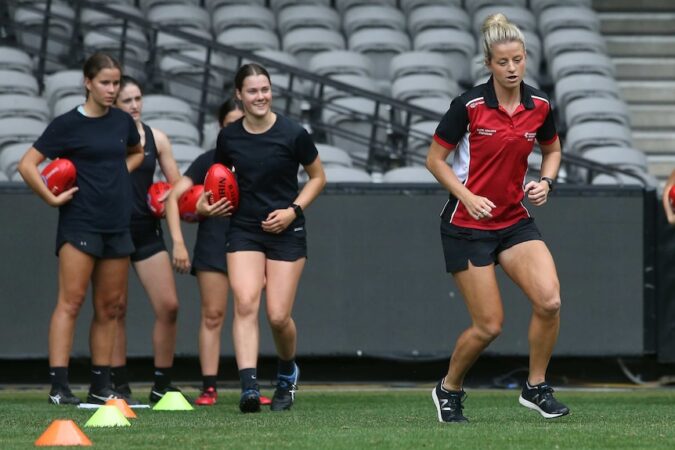
Fifty per cent of the population have breasts, but it’s still a taboo topic in locker rooms, according to AFLW All-Australian and premiership player Libby Birch.
And that taboo contributes to the fact that girls are less likely to play sport than boys, once they start going through puberty.
In her eight years playing at an elite level, Birch said “it’s only recently that I’ve received training on breast support and protection in the sport”.
Birch wants this to change, and for girls and women to feel comfortable talking about their boobs with their peers and coaches.
Three-quarters of Australian women experience breast pain
One of the big physical changes a girl experiences when she goes through puberty is a change in her breasts (amongst other things).
They become bigger, heavier and tenderness can develop. It can be an awkward and stressful process.
And nearly three-quarters of Australian women experience mastalgia (breast pain) at some point during their lives, according to Westmead Breast Cancer Institute.
Mastalgia is something women usually experience in their 20s and 30s during a menstrual cycle.
Director of Breast Research Australia at the University of Wollongong, Associate Professor Deidre McGhee, is determined to make sure all breasts are “covered”, and is pioneering research on the barriers women’s breasts can have on physical activity levels and athletic performance.
“A bra is like a pair of shoes, they fit everyone differently,” she said.
She is pushing for sports bras to be included as part of a player’s uniform kit, rather than something that girls and women are expected to buy themselves.
Until recently, there has only been one large-scale study conducted on women’s breast injuries in contact sports.
Associate Professor McGhee said one of the reasons might be that when women are given a chart to show the location of their injury, the chart is often of a male.
“A lot of women also don’t always feel comfortable talking about their breast support needs or injuries because a lot of people in leadership and coaching positions are men,” she said.
“This makes them feel uncomfortable.”
Girls learning tackle techniques to protect breasts
In October 2019, the Australian Institute of Sport started the Female Performance and Health Initiative. The main goal was to improve knowledge and support in relation to girls and women in sport.
Since then, 14 modules and educational resources have been developed on topics ranging from a women’s menstrual cycle, through puberty and development, to breast health.
Former AFLW development coach and injury prevention researcher at LaTrobe University Brooke Patterson spends much of her time talking to coaches at a community level.
She teaches them how to train girls who are playing Australian rules on the best tackling techniques to prevent serious injuries including injuries to the breast.
“It’s important to talk about ways to tackle differently so you can better protect your breasts,” Patterson said.
“But it’s also important to help coaches feel comfortable doing that … without feeling like they’re stepping over a personal boundary.”
At the same time, girls and women need the confidence to ask for help or guidance.
But it’s not just up to coaches and girls playing sports.
A recent study published in Science and Medicine in Football found almost 60 per cent of elite female athletes have experienced an injury to their breasts, but only one in 10 go on to report it to either their medical oversight professional or coach.
Patterson and Associate Professor McGhee both believe physiotherapists and medical practitioners require upskilling across the board, to better equip them with the tools needed to identify breast injuries.
That way when a girl or women visits a clinic, problems can be diagnosed and treated with confidence, allowing the patient to feel heard and seen.
Is protective gear the solution?
Some experts also believe women could wear protective gear as a way to tackle the situation.
Due to the location of breasts, they are more vulnerable and susceptible to an impact injury during contact sport.
Suzie Betts is the owner of Boob Armour, a company that designed removable bra cups.
Questioning why mouthguards, shin guards and boxes are included as part of a “uniform”, but breast protection is not, Betts said she wants to see girls able to play sport with the same confidence boys do.
The current AFLW collective bargaining agreement, for example, stipulates boots and sports bras as requirement when it comes to a player’s “tools of the trade”, but clubs only have to pay for boots.
So, is it the players’ responsibility to protect their breasts, the clubs, or the sporting code?
Birch said it should be a mix.
She has experienced bruising on her breasts, and tenderness, but said playing while wearing boob protection makes her feel less vulnerable when tackling or marking the ball.
She is also advocating for medical staff to have the right training to better diagnose and treat breast injuries, and wants to see sports bras and breast protection as an option in women’s sporting kits.
Associate Professor McGhee has strong hopes for girls and women in Australia, but ultimately her goal is to see a global approach to breast injury prevention based on research in a bid to create change.
So, whether it’s a right fitting bra or protective cups, experts agree – more research and attention is needed on breasts in contact and combat sports.
“No woman should be stressed about her breasts,” Birch said.
Sports content to make you think… or allow you not to. A newsletter delivered each Friday.
Source: AFL NEWS ABC



